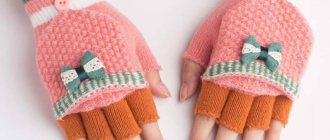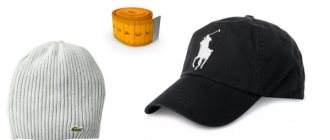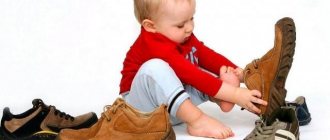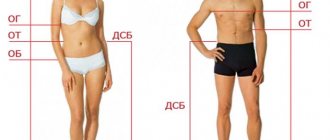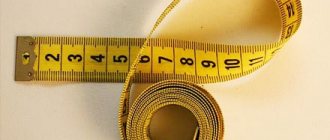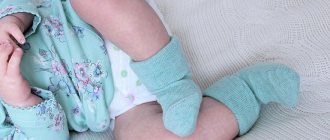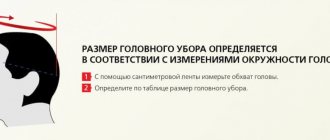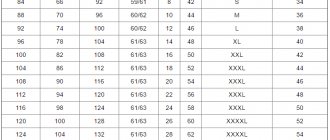Creating a children's wardrobe is not only a very exciting and entertaining process that evokes emotion, but also a very difficult task that requires certain knowledge. Why is it sometimes so difficult to determine the size and height of a child’s clothes? It's all about different performance grids and tables: Russian, European, Chinese, etc. Based on the information presented below, you will learn how to choose the right things for children, eliminating any errors.
How to determine a child's clothing size
Just a couple of decades ago, high-quality children's clothes were in short supply and it was almost impossible to get them. Today, the situation has changed dramatically, providing parents with a wide choice of a wide variety of clothes for their children: from practical everyday outfits to weekend and holiday ones.
Modern stores tempt new mothers and fathers with a rich assortment, providing products for every taste and color. New opportunities give rise to additional problems - in order to choose a beautiful product, you need to know the exact size of your child. But how to define it? First, you should take measurements, clarifying the baby’s parameters. Next, you should resort to special tables of height and clothing sizes for children.
How to correctly measure a child's parameters?
To clarify children's parameters, first of all, it is necessary to take measurements. Below is a list of tips and recommendations on how to correctly determine the size of a child’s clothing based on height and volume:
- First of all, measure the baby's height. Lean it back against the wall, make a mark corresponding to its length. Next, determine the distance from the floor to the notch using a centimeter or tape measure.
- Proceed to take measurements from the chest. The girth is determined along the following trajectory: the protruding areas of the chest, the middle of the shoulder blades.
- The next step is to determine your waist size. Be careful that the measuring tape is not too tight on your torso.
- The hips are measured along the widest circumference - the prominent areas of the thighs and gluteal muscles.
- Having finished with standard measurements, proceed to determine the length of the sleeves. This parameter is determined as follows: the child bends his arm at the elbow while the parent determines the distance from the shoulder to the radial wrist, bypassing the elbow.
The final measurement is the trouser length. To carry it out, you need to measure the distance from the middle of the torso to the ankles on the side.
| Age | Height, cm | Waist circumference, cm | Chest circumference, cm | Clothing size |
| 0-1 month | 50-56 | — | — | 78 |
| 1-3 months | 62-68 | — | — | 20 |
| 3-6 months | 68-74 | — | — | 22 |
| 6-9 months | 74-80 | — | — | 24 |
| 9-12 months | 80-86 | — | — | 26 |
| 2 years | 92-98 | 51-53 | 54-56 | 28 |
| 3 years | 98-104 | 52-54 | 55-57 | 20-30 |
| 4 years | 104-110 | 53-55 | 55-57 | 30 |
| 5 years | 110-116 | 54-56 | 57-59 | 30-32 |
| 6 years | 116-122 | 55-58 | 58-62 | 32 |
| 7 years | 122-124 | 57-59 | 61-65 | 34 |
| 8 years | 124-128 | 58-61 | 64-68 | 34-36 |
| 9-10 years | 134-140 | 60-62 | 67-71 | 36 |
| 11-12 years old | 146-152 | 64-68 | 75-79 | 38 |
| 13-14 years old | 158-164 | 68-72 | 82-87 | 40-42 |
| 15-16 years old | 166-176 | 70-75 | 89-94 | 42-44 |
Metric size chart for children's clothing
Any parent can take measurements of their own child. However, it is these parameters that play a decisive role when selecting things. The table below on how to find out what size clothes a child has by height will help when putting together a wardrobe.
| Size | Age | Height | Bust |
| 18 | 0-1 | 50-56 | — |
| 20 | 1-3 | 56-68 | — |
| 22 | 3-6 | 68-74 | — |
| 24 | 6-9 | 74-80 | — |
| 26 | 9-12 | 80-86 | — |
| 28 | 2 | 92-98 | 54-56 |
| 28/30 | 3 | 98-104 | 55-57 |
| 30 | 4 | 104-110 | 55-57 |
| 30/32 | 5 | 110-116 | 57-59 |
| 32 | 6 | 116-122 | 58-62 |
| 34 | 7 | 122-128 | 61-65 |
| 34/36 | 8 | 128-134 | 64-68 |
| 36 | 9 | 134-138 | 67-70 |
| 36/38 | 10 | 138-142 | 69-72 |
What size clothes does a 1 year old child have?
Perhaps only his own mother or an experienced store salesperson can guess the size of a child’s clothes at first glance. What should you do if you are going to give a gift to your one-year-old nephew and have absolutely no idea what his clothing size is? Use tips from LOLOCLO!
Options
The main parameter by which the size of children's clothing is determined is the child's height. There are tables that correlate the height, age and circumference of the chest, hips and waist of the child. This is the average statistical data on which clothing factories operate. There are also GOST standards according to which children's clothing is sewn - all sizes are standardized and rarely change. Thus, knowing how many months the baby is, you can determine its approximate size. For example, if a child is one year old, then his height is on average about 80 cm. These parameters correspond to clothing size 80. However, even here a surprise awaits the caring aunt: the number “24” may appear on the label. What does it mean?
Types of clothing sizes
You can find several size ranges on the market: Russian, European and standard. The most popular is the standard one, and we’ll talk about it first. The smallest size in this line is 50. It is designed for newborn babies, and is also suitable for babies who were born prematurely. The step of the size range is not 2, as in adults, but 6, respectively, the next size is 56. This is one of the most popular and popular sizes, which is suitable for both girls and boys from 50 cm tall and in the first month of life. Clothes of size 62 are worn on heroes who were born with a height of 53 cm, as well as for children aged 1 to 2 months.
The Russian system of clothing sizes for newborns is established by GOST and starts from size 18. It is suitable for babies in the first days of life, as well as for premature babies. Size 20 is intended for babies under 1 month of age, as well as strong ones who were born very large. The next size - 22 - is suitable for those who are about to turn 1.5 months old. The European grid is perhaps the easiest to remember and the most unpredictable when trying on. For a new family member, you need the size indicated by the numbers “0/3”. It is suitable for babies aged 0 to 3 months.
Size rulers
There are several size ranges for children's clothing. The standard one starts at 50 and has a step of six. Accordingly, size 80 or 86 is suitable for a one-year-old child if the baby is large or grows faster than others. Russia has its own size range, which starts from size 18. For a 12 month old baby, size 24 clothes are suitable. In addition, it is designed for one and a half year old children. In Europe, for babies who have celebrated their first birthday, the letter system that everyone is familiar with is adopted - you need size S (small).
Sizes of panties and trousers
We've sorted out the blouses, dresses and T-shirts, now we're starting to study the “bottoms”. To choose the right pants, you also need to know the age and height of the baby. In order for the trousers to fit well, you also need to know what the circumference of the baby’s waist and hips is. Sometimes these numbers are decisive, because each baby has its own figure. For a one-year-old baby, trousers of size 22 or 24 are suitable, depending on the volume.
Accessory sizes
A cute hat is a wonderful and necessary accessory. When selecting, it is also important to know the approximate age of the child. On average, the head circumference of one-year-old babies is about 47-49 cm. This figure is also indicated by the manufacturer on the label. In foreign clothing this size corresponds to XS. Sock sizes for a 1 year old child are 13 or 14, tights are 80-86.
Size chart for children's clothing (Russia, Europe, China, USA)
Russian, European, Chinese and American manufacturers do not adhere to the same parameters when sewing things. The photo below shows the current table of clothing sizes for children by age.
Important tips on how to understand what size clothes your child has:
- When placing an order from a foreign online store, review the metric indicators declared by the manufacturer and compare them with the data in the table presented above.
- When purchasing items from European suppliers, pay attention not only to height parameters, but also to chest, waist, and hip measurements.
Also, when purchasing clothes for newborns, remember that children grow especially quickly during this period. Perhaps it would be more advisable to purchase a wardrobe “for growth”.
Sizing chart for children's clothing.
| Russian size | 30/32 | 32/34 | 36/38 | 38/40 | 40/42 | 42 |
| US size | 2 (125) | 5 (135) | 7 (150) | 9 (155) | 11 (160) | 13 (165) |
| European size | 4 | 6 | 8 | 10 | 12 | 14 |
Sizing chart for children's shoes.
| Russian size | 31 | 32 | 33 | 34 | 35 | 36 |
| US size | 1 | 2 | 3 | 4 | 5 | 6 |
| European size | 32 | 33 | 34 | 35 | 36 | 37 |
| In centimeters | 20 | 20,5 | 21,5 | 22 | 23 | 24 |
European and American sizes of children's clothing
The key merit of children's clothing manufacturers from Europe and the United States is that they always accurately indicate height parameters and volume measurements. Based on this information, you can always choose suitable products, even without knowing the specific size indicators.
American and European clothing size tables for children by age are below.
| Height (cm) | Weight (lb) | Weight, kg) | Hips (cm) | |
| newborns | up to 50 | up to 7.8 | up to 3.4 | — |
| up to 1 month | up to 56 | to 10 | up to 4.5 | — |
| up to 3 months | 56-62 | 10-14 | 4,5-6 | — |
| 3-6 months | 62-68 | 14-18 | 6-8 | — |
| 6-9 months | 68-74 | 18-21 | 8-9,5 | — |
| 9-12 months | 74-80 | 21-24 | 9,5-11 | — |
| 12-18 months | 80-86 | 49-51 | 50-51 | 52-54 |
| 18-24 months | 86-92 | 51-53 | 51-52 | 54-56 |
| 2-3 years | 92-98 | 53-55 | 52-53 | 56-58 |
| 3-4 years | 98-104 | 55-57 | 53-54 | 58-60 |
| 4-5 years | 104-110 | 57-59 | 54-55 | 60-62 |
| 5-6 years | 110-116 | 59-61 | 55-57 | 62-65 |
| 7-8 years | 122-128 | 63-67 | 58-60 | 68-71 |
| 9-10 years | 134-140 | 69-73 | 51-64 | 73-78 |
| 11-12 years old | 146-152 | 75-79 | 54-68 | 79-84 |
| 13-14 years old | 158-164 | 82-87 | 68-72 | 85-92 |
| 15-16 years old | 166-176 | 89-94 | 70-75 | 90-96 |
Table of children's clothing sizes from Europe by height and volume
European manufacturers form their metric grid based on the ratio and correspondence of height and clothing size for children.
The size chart with current information for 2018 is presented below.
| International sizes/ages | Russian sizes | Breast | Waist | Hips | Height | Weight |
| XS (4-6) | 28-30 | 64 cm | 61 cm | 66 cm | 117 cm | up to 25 kg |
| S (6-8) | 32-34 | 69 cm | 61 cm | 71 cm | 134 cm | up to 32 kg |
| M (8-10) | 36 | 74cm | 64 cm | 76 cm | 140 cm | up to 36 kg |
| L(10-12) | 38 | 76cm | 66 cm | 81 cm | 147 cm | up to 41 kg |
European size chart of clothing sizes for children by age
When a parent does not know the clear metric indicators of his child, he can use a table by age. It looks like this:
| Size (Euro) | Height | Age | Weight |
| 50 | 45-50 | 1 month | 3-4 kg |
| 56 | 51-56 | 2 months | 3-4 kg |
| 62 | 57-62 | 3 months | 4-5 kg |
| 68 | 63-68 | 3-6 months | 5-7 kg |
| 74 | 68-75 | 6-9 months | 7-9 kg |
| 80 | 75-80 | 12 months | 9-11 kg |
| 86 | 81-86 | 1.5 years | 11-12 kg |
| 92 | 87-92 | 2 years | 12-14.5 kg |
| 98 | 93-98 | 3 years | 13.5-15 kg |
| 104 | 99-104 | 4 years | 15-18 kg |
| 110 | 105-110 | 5 years | 19-21 kg |
| 116 | 111-116 | 6 years | 22-25 kg |
| 122 | 117-122 | 7 years | 25-28 kg |
| 128 | 123-128 | 8 years | 30-32 kg |
| 134 | 129-134 | 9 years | 31-33 kg |
| 140 | 135-140 | 10 years | 32-35 kg |
| 146 | 141-146 | 11 years | 33-36 kg |
Chinese children's sizes
Things from Chinese manufacturers are in particular demand in Russia. They have a very specific size chart, which makes choosing a wardrobe much more difficult. How to measure the size of clothes for a child in this case? Special table tips will help you.
It is noteworthy that here importance is attached not so much to the height or volume of children, but to their age. Therefore, the main table is divided into two types:
- Chinese size chart for children (from 0 to 2 years)
| Age, years | Height, cm | Size marking |
| from 0 to 2 | 56 | 0 |
| 3 months | 58 | 3 |
| 4 months | 62 | 3 |
| 6 months | 68 | 6 |
| 9 months | 74 | 6-12 |
| 12 months | 80 | 12 |
| 18 months | 86 | 18 |
| 24 months | 92 | 24 |
- Chinese size of children's clothing (table for children from 3 to 14 years old).
| Age, years | Height, cm | Size marking |
| 3 | 98 | 3 |
| 4 | 104 | 4 |
| 5 | 100 | 51 |
| 6 | 116 | 6 |
| 7 | 122 | 7 |
| 8 | 128 | 8 |
| 9 | 134 | 9 |
| 10 | 140 | 10 |
| 11 | 146 | 11 |
| 12 | 152 | 12 |
| 13 | 156 | 13 |
| 14 | 158 | 14 |
Determining the size of T-shirts and T-shirts
For children under four years old, with standard equipment, it is enough to know their height. After the age of four, the size of a T-shirt is determined by four parameters:
- height;
- waist circumference (measure by stretching a measuring tape at the thinnest point);
- chest girth (we pull the tape through the armpits, shoulder blades);
- hip circumference (we stretch the tape through the most convex points of the buttocks).
To obtain the most correct parameters, the child should be wearing underwear or light clothing. Until the age of two, height is measured while lying down. If your baby is a big fidget, take measurements from clothes that fit him.
Table of Russian sizes of children's T-shirts from 0 to 6 years
| Size | 18 | 20 | 22 | 24 | 26 | 28 | 30 |
| Height, cm | 50-56 | 62-68 | 74 | 80 | 86-92 | 98-104 | 110-116 |
| Chest circumference, cm | 40 | 44 | 44 | 48 | 52 | 54-56 | 60 |
| Waist circumference, cm | 40 | 44 | 45 | 48 | 52 | 52-54 | 54 |
| Age | 0-1.5 months | 1.5-6 months | 6-9 months | 9-12 months | 1-2 years | 3-4 years | 4-6 years |
Table of Russian sizes of children's T-shirts from 7 to 14 years
| Size | 30 | 32 | 32 | 34 | 36 | 38 | 40 | 42 |
| Height, cm | 122 | 128 | 134 | 140 | 146 | 152 | 158 | 164 |
| Chest circumference, cm | 58-62 | 61-65 | 64-68 | 67-71 | 70-74 | 75 | 78 | 81 |
| Waist circumference, cm | 66-67 | 68-70 | 70-72 | 74 | 78 | 82 | 86 | 90 |
| Age | 7 years | 8 years | 9 years | 10 years | 11 years | 12 years | 13 years | 14 years |
Often the height is written on the label of the item, this helps to more accurately determine the choice of size.
Children's underwear size chart
We have not forgotten those times when underwear for children was bought “in front of our eyes.” Fortunately, modern parents can easily abandon so many irrational methods by simply resorting to the help of special dimensional grids and tablets.
For girls and boys
| Age | Tights size | Foot length |
| 3-6 months | 62-68 | 8-10 |
| 6-9 months | 68-74 | 10-12 |
| 1-1.5 years | 80-86 | 12-14 |
| 1.5-2 years | 86-92 | 12-14 |
| 3-4 years | 98-104 | 14-16 |
| 4-5 years | 104-110 | 16-48 |
| 5-6 years | 110-116 | 18-20 |
| 6-7 years | 116-122 | 18-20 |
| 8-9 years | 128-134 | 20-22 |
| 9-10 years | 134-140 | 22 |
| 11 years | 140-146 | 24 |
| 12 years | 152-128 | 24 |
Size matching for children's clothing and some other useful tables
When it comes to organizing your kids' wardrobe, you can never have enough useful information. Below is a number of auxiliary tables that will simplify the process of selecting things and help you avoid getting into an awkward situation.
| Height (cm) | Age | Russia (old size) | Russia (new size) | England | Europe | USA | China |
| 50-56 | 0-1 month | 18 | 36 | 2 | 56 | 0/3 | |
| 62-68 | 1-3 months | 20 | 40 | 2 | 68 | 0/3 | |
| 68-74 | 3-6 months | 22 | 44 | 2 | 74 | 3/6 | 4 |
| 74-80 | 6-9 months | 24 | 48 | 2 | 80 | 6/9 | 4 |
| 80-86 | 9-12 months | 26 | 52 | 2 | 86 | 6/9 | 6 |
| 92-98 | 12-24 months | 28 | 56 | 4 | 98 | 2T/2 | 8 |
| 98-104 | 24-36 months | 28-30 | 56-60 | 4 | 104 | 3T/3 | 10 |
| 104-110 | 4 years | 30 | 60 | 4 | 110 | 4T/4 | 12 |
| 110-116 | 5 years | 30-32 | 60-64 | 6 | 116 | XS, S | 12 |
| 116-122 | 6 years | 34 | 68 | 6 | 128 | s | 14 |
| 122-128 | 7 years | 34 | 68 | 6 | 128 | s | |
| 128-134 | 8 years | 34-36 | 68-72 | 8 | 134 | s | |
| 134-140 | 9-10 years | 36 | 72 | 8/10 | 140 | m | |
| 140-146 | 10-12 years | 38 | 76 | 8/102 | 156 | m | |
| 146-125 | 12-14 years old | 40 | 80 | 12 | 152 | m | |
| 158 | 14-16 years old | 42 | 84 | 14 | 158 | l | |
| 164 | 16-18 years old | 44 | 88 | 16/18 | 164 | xl |
| Size | Height | Age | Weight | Bust volume | Waist | Hip volume | Inseam length |
| 18 | 50 | 1 | 3-4 | 41-43 | 41-43 | 41-43 | |
| 18 | 56 | 2 | 3-4 | 43-45 | 43-45 | 43-45 | |
| 20 | 62 | 3 | 4-5 | 45-47 | 45-47 | 45- 47 | |
| 22 | 68 | 3-6 | 5-7 | 47-49 | 46-48 | 47-49 | |
| 24 | 74 | 6-9 | 7-9 | 49-51 | 47-49 | 49-51 | |
| 24 | 80 | 12 | 9-11 | 51-53 | 48-50 | 51-53 | |
| 24 | 86 | 1,5 | 11-12 | 12-54 | 49-51 | 52-54 | 31 |
| 26 | 92 | 2 | 12-14,5 | 53-55 | 50-52 | 53-56 | 35 |
| 26 | 98 | 3 | 13,5-15 | 54-56 | 51-53 | 55-58 | 39 |
| 28 | 104 | 4 | 15-18 | 55-57 | 52-54 | 57-60 | 42 |
| 28 | 110 | 5 | 19-21 | 56-58 | 53-55 | 59-62 | 46 |
| 30 | 116 | 6 | 22-25 | 57-59 | 54-56 | 61-64 | 50 |
Summary of the size range of children's clothing for different manufacturers (table):
| EUROPE (cm) | XS | S | M | L | XL |
| age | 6 | 8 | 10 | 12 | 14 |
| height | 116 | 128 | 140 | 152 | 162 |
| JAPAN (cm) | S | M | L | XL | XXL |
| height | 113-123 | 124-134 | 135-145 | 146-155 | 156-165 |
| breast | 62 | 67 | 72 | 78 | 84 |
| waist | 57 | 60 | 64 | 68 | 72 |
| hips | 68 | 73 | 78 | 84 | 90 |
| inseam | 53 | 59 | 65 | 72 | 79 |
| the length of the sleeve | 53 | 59 | 65 | 72 | 79 |
| US/CANADA (inches) | XS | S | M | L | XL |
| age | 6 | 8 | 10 | 12 | 14 |
| height | 44-48 | 49-53 | 54-57 | 58-61 | 62-65 |
| breast | 24,5 | 26,5 | 28,5 | 30,5 | 33 |
| waist | 22,5 | 23,5 | 25 | 27 | 28,5 |
| hips | 27 | 28,5 | 30,5 | 33 | 35,5 |
| inseam | 21 | 23,5 | 25,5 | 28,5 | 31 |
| the length of the sleeve | 21 | 23,5 | 25,5 | 28,5 | 31 |
European and American table
There are foreign labels for both adults and children. When ordering things from online stores, the buyer often encounters them, which creates difficulties in choosing the right size. The correspondence table will help with this.
Size chart for European, American and Russian sizes.
| Russia | 18 | 18 | 20 | 22 | 22 | 24 | 24 | 26 | 26 | 28 |
| Europe | 50 | 56 | 62 | 68 | 74 | 80 | 86 | 92 | 98 | 104 |
| America | 0 | 0-3 | 0-3 | 3-6 | 6-9 | 12 | 18 | 2/2T | 3T | 4T |
| Russia | 28 | 30 | 30 | 32 | 32 | 34 | 36 | 38 | 40 |
| Europe | 110 | 116 | 122 | 128 | 134 | 140 | 146 | 152 | 158 |
| America | 5 | 6 | 6 | 7 | 7 | 8 | 10 | 12 | 14 |
When you have difficulties choosing a T-shirt, give preference to a larger size, since the baby is growing quickly and in the near future the item will fit. This is especially useful to know for those who often buy things as gifts. European and Russian size ranges are basically the same, but there are some differences. In Russia, clothing is designed for thinner children with smaller breasts than in European countries. But manufacturers strive for European standards. Therefore, when choosing a T-shirt size, you need to pay attention not only to height, but also to chest circumference.
The above tables of sizes for children's T-shirts will undoubtedly come in handy if you have to order clothes online or if your baby is not with you in the store. But still, there is nothing better than trying on!
Standard sizes of children's hats
Every parent cares not only about the health, but also the comfort of their baby, and strives to surround him with beautiful and practical things. Hats are important elements of a child's wardrobe, which are designed to prevent hypothermia or protect from direct sunlight.
To choose a hat or panama hat that will fit well on the head and will not fall off at the first sudden movement, you need to know the correct parameters of the child. They are measured along a trajectory: the line above the eyebrows, the middle of the back of the head. Next, the obtained metric data is compared with the table values and the size of the headdress is determined.
The photo below shows the current size range of hats for 2021.
| Age | Head volume, cm |
| 0-3 months | 35-40 |
| 3-6 months | 42-44 |
| 6-12 months | 44-46 |
| 1-2 years | 46-48 |
| 2-3 years | 48-50 |
| 3-4 years | 50-52 |
| 4-5 years | 52-54 |
| 5-8 years | 54-56 |
| 8-10 years | 56-58 |
| over 10 years old | 58-60 |
Unfortunately, it is not always possible to measure head circumference. In this case, you can use a table that determines the size of the headdress based on the ratio of the child’s height and age.
| Size | Height (cm) | Age |
| 35 | 50-55 | 0-3 months |
| 40 | 56-61 | 3 months |
| 44 | 62-67 | 6 months |
| 46 | 68-73 | 9 months |
| 47 | 74-79 | 12 months |
| 48 | 80-85 | 18 months |
| 49 | 86-91 | 2 years |
| 50 | 92-97 | 3 years |
| 51 | 98-103 | 4 years |
| 51 | 104-109 | 5 years |
| 53 | 110-115 | 6 years |
| 54 | 116-121 | 7 years |
| 55 | 122-127 | 8 years |
| 56 | 128-133 | 9 years |
| 56 | 134-139 | 10 years |
| 58-57 | 140-146 | 11 years |
Methods for determining the conformity of clothing sizes according to tables for Russia
In Russia, a standard grid corresponding to GOST is used to determine the size range of clothing.
- The size range starts from the age of the child from 0 years.
- At 0 months the value is 18, at 3 months the size is 20, at six months the value is 22. In the period from 6 months to two years the size range does not change and is 24.
- After this, approximately every 2 years, the size range of clothing for a child will increase by 2 points.
This table with parameters will help you determine the appropriate size for your child. But don't forget about fitting. Very often, overweight children need clothes a couple of sizes larger than indicated in the table opposite their height and age.
Size chart for children's tights
Childhood is that period of life when tights are the most important element of the wardrobe. They help protect the child from hypothermia and insulate his autumn and winter clothes. In some cases, they are even worn separately from trousers or skirts - as an independent item.
What information do you need to have to determine your children's tights size?
- baby's age;
- his height.
In some cases, metric waist and hip measurements may be required. The table below will help you select the right tights.
| Age | Height (cm) | Hip circumference (cm) | Foot length(cm) |
| 0-1 year | 68-74 | 48 | 12 |
| 1-2 years | 80-86 | 48-52 | 14 |
| 2-3 years | 92-98 | 58 | 14 |
| 4-5 years | 104-110 | 60-62 | 16 |
| 6-7 years | 116-122 | 64-66 | 18 |
| 8-9 years | 128-134 | 68-72 | 20 |
| 10-11 years | 140-146 | 76-80 | 21 |
| 12-13 years old | 150-152 | 84 | 22 |
Finally, briefly about the important
Below is a list of useful tips and recommendations that will help you not make a mistake with the size and choose the right thing:
- Children of the same age and height can differ greatly from each other, having different volumes and types of figures. That is why, if you do not have the opportunity to try on an item, always compare the baby’s metric parameters with the data indicated by the manufacturer.
- Russian clothing factories designate sizes using numbers: number/height.
- American and European manufacturers designate sizes in letters, but this rule is relevant for children over three years old.
- As a rule, the most important indicators are height and age, while other data are considered secondary.
- It is assumed that the European size chart is designed for larger children than the Russian one. This is due to the peculiarities of the mentality of Europeans. They are convinced that children's clothes cannot be tight-fitting and should not restrict movement.
- As a rule, French clothing runs very small, while Italian clothing creates the opposite effect.
- It is very dangerous to buy Chinese items without trying them on, since in reality the parameters may differ greatly from what the manufacturer stated. In addition, they tend to shrink after washing. This feature must be taken into account when purchasing clothes.
- You should not buy outerwear without trying it on. It is important that the child can move comfortably in a jacket or sheepskin coat, so that it does not constrain him or is too tight. Take into account the fact that you will need to fit warm clothes under your outerwear: sweaters, jackets.
- When creating a children's wardrobe, give preference to things made from natural fabrics and materials. Synthetics impede air circulation and can create a greenhouse effect, which is not very beneficial for the delicate skin of a child.
Also, remember an important rule: new things should always be washed before wearing. This will refresh them and get rid of any industrial dust or germs.
Children's size chart, clothing height, what is children's size
| Age | Size | Height (cm) | Chest (cm) |
| 1 year | 22 | 80-86 | 44 |
| 1.5-2 years | 24 | 86-92 | 48 |
| 2-3 years | 26 | 92-98 | 52 |
| 3-4 years | 28 | 98-110 | 56 |
| 4-5 years | 30 | 110-116 | 60 |
| 5-6 years | 32 | 116-122 | 64 |
| 6-7 years | 34 | 122-128 | 68 |
| 8-10 years | 36 | 128-146 | 72 |
| 10-12 years | 38 | 146-152 | 76 |
| 12-14 years old | 40 | 152-164 | 80 |
| 14-16 years old | 42 | 164-177 | 84 |
Features of determining T-shirt sizes in the USA
If you want to purchase goods from another country or order clothes online, you should take into account the differences in determining the size range. The correct choice of clothing depends on this. To choose the right T-shirt, you should use a comparative grid indicating the size range of different countries. The classic determination method is the following:
- In America, there are three categories of clothing depending on the age group: Newborn, Toddler, Youth.
- For a child's age from 0 to 24 months, each size corresponds to the child's age in months.
- For children from 2 to 6 years old, the marking of clothing coincides with the number of full years; the letter “T” may appear next to the number.
- In the Youth category, models are presented for children from 6 to 14 years old, which are designated S, M, L, XL, XXL (in ascending order from 6 to 14 years old with an interval of 2 years).
